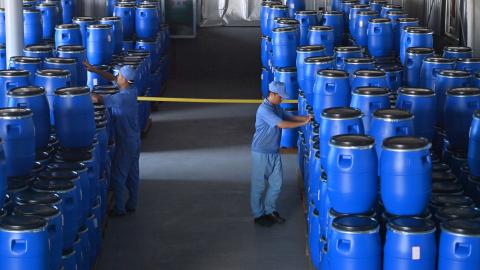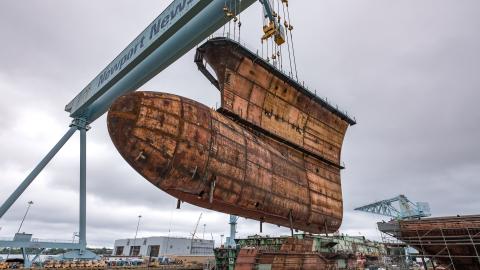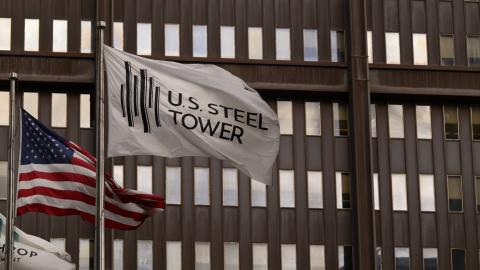Labor votes in the Midwest are at a premium in this tight presidential race, and nowhere is that truer than in Pennsylvania. To woo the United Steelworkers Union (USW), President Biden announced last month plans to triple Section 301 tariffs on Chinese steel, invited USW president David McCall to the White House for a state dinner in April and then joined the USW in opposing Nippon Steel’s purchase of U.S. Steel, claiming that it was vital for the latter to remain “domestically owned and operated.”
When announcing the tariffs, Biden pointed out that steel made in the U.S. “emits half as much carbon as steel made in China.” The carbon reductions in the U.S. are only possible because much of domestic steel is produced not by old-fashioned blast furnaces, but by recycling scrap steel in electric arc furnaces.
Much of the labor force at these electric arc furnaces are non-union labor. Blast-furnace steel mills like the U.S. Steel-owned Mon Valley Works, outside of Pittsburgh, still employ many USW workers.
Preventing the sale
Fear of losing jobs in these older style plants is behind the USW’s campaign to prevent the Japanese steel giant, Nippon Steel Corporation, from acquiring U.S. Steel, one of two U.S. steelmakers still using blast furnace technology. The USW wants U.S. Steel to go to Cleveland-Cliffs, surrendering its rights to approve any U.S. Steel sale to the Ohio company.
Its rejection of Nippon Steel in favor of a single alternative will endanger their objectives in the long run. Engaging with Nippon Steel at the negotiation table is the best way to ensure a long-term legacy of union steelmaking in Pittsburgh
The USW and Nippon Steel did meet in Pittsburgh on March 7 to discuss how Nippon Steel would abide by the union’s Basic Labor Agreement (BLA) with U.S. Steel. Despite guarantees to support union members at blast furnace plants, including no layoffs before September 2026 and $1.4 billion of capital investment, the USW leadership has refused to meet further.
The union believes Nippon Steel is using legalese to evade BLA obligations. Nippon Steel is only using standard business language to account for unexpected and extreme circumstances. The USW would be better off meeting with Nippon Steel to hammer out iron-clad assurances.
Regulatory effects
The USW should also be wary of mistrusting Nippon Steel and placing its trust in Cleveland-Cliffs because of likely regulatory and economic results.
Only blast furnace mills can produce certain steel needed by industries, such as automobiles. A Cleveland-Cliffs and U.S. Steel merger would control 100% of blast furnace production in the U.S., 100% of the U.S. production of electrical steel used in EV motors and electrical grids, and 95% of domestic upstream iron ore production.
The combined steel entity would likely trigger immediate federal antitrust action to order, at minimum, the divestiture of parts of the new company. The divestiture amounts differ: Cleveland-Cliffs estimates $2 billion; U.S. Steel estimates $7 billion, or nearly the entire value of the original $7.3 billion Cleveland-Cliffs bid.
Regardless of the amount, any divestiture would risk the loss of jobs. A merger with Nippon Steel would not create such monopolies.
The union’s bigger concern, however, should be about the future. Union workers’ blast furnace steel plants need new technological investment. Cleveland-Cliffs cannot make those investments, as it lacks Nippon Steel’s capital resources, and prefers to spend $600 million on stock buybacks in the first quarter of 2024 and has announced a further $1.5 billion in stock buybacks. These buybacks will force it to take on more debt, rather than making any investments.
In contrast, a Nippon Steel merger would permit technology transfers that will make U.S. Steel’s blast furnace plants more competitive and viable in the long-term. In addition to the $1.4 billion capital investment already mentioned, Nippon Steel has pledged $500 million a year in R&D to U.S. Steel, a sharp uptick from the $40 million that U.S. Steel previously spent.
At the heart of this technology transfer is Nippon Steel’s hydrogen-injection blast furnaces. Using hydrogen instead of coke to reduce iron ore, Nippon Steel already can reduce carbon emissions by 33% and expects to achieve 50% by 2040. At those figures, blast furnace steel becomes as low-carbon as electric arc furnace steel.
These advances should address USW concerns that Nippon Steel will favor electric arc mills and shutter union-heavy blast furnace mills, such as the Mon Valley Works outside of Pittsburgh.
A beneficial purchase
Nippon Steel’s purchase of U.S. Steel will benefit USW’s families, friends, and communities as well. The company has pledged to retain U.S. Steel’s name and headquarters, and will move its own North American offices from Houston to downtown Pittsburgh.
USW leaders have an obligation to support and advocate for their members. Pinning all their hopes on Cleveland-Cliffs is risky. The union should negotiate with Nippon Steel and secure the guarantees and investments that will strengthen USW members and their blast furnace mills in the long term.

















